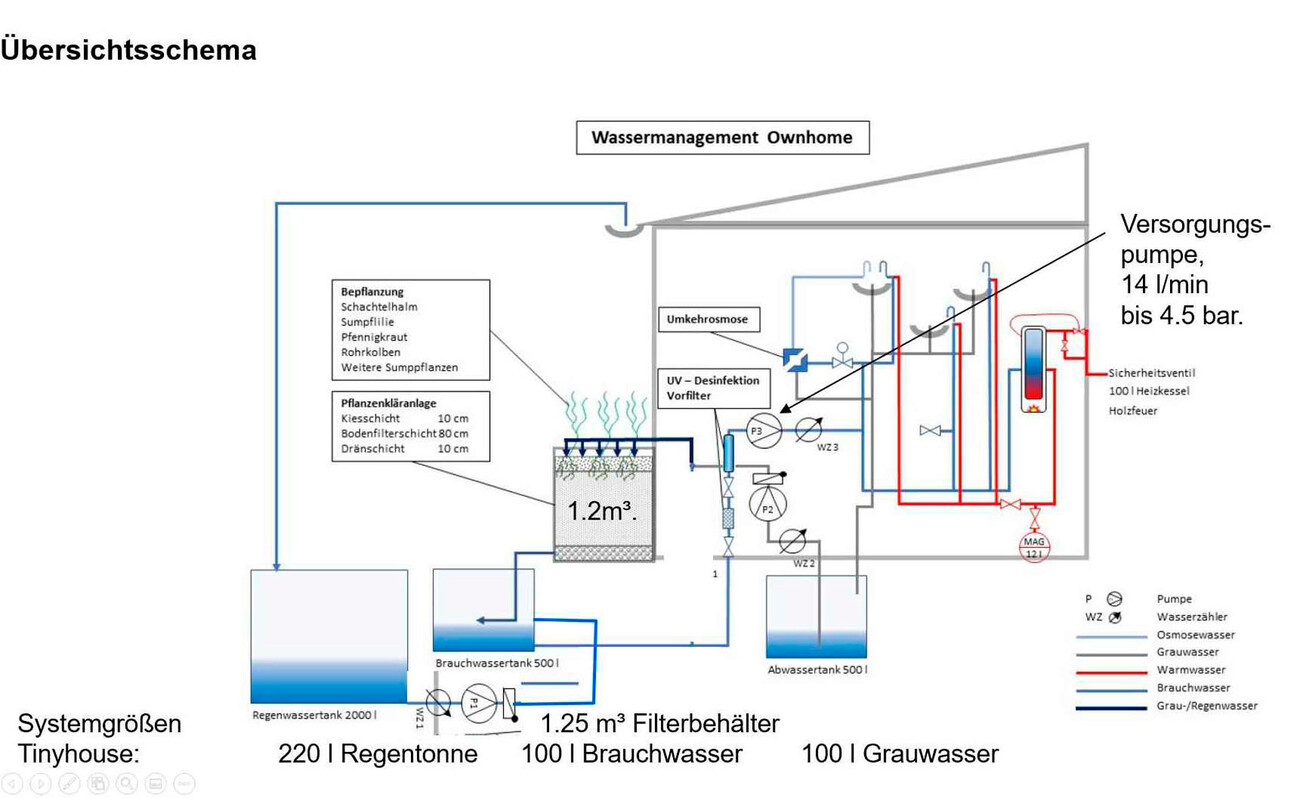The Ownhome Concept or Decentralized Small Waterworks, Oberbechingen, Allemagne

Greywater use in the Tinyhouse
An important part of the Ownhome concept is the distinct separation of wastewater streams for their efficient recycling. Avoiding mixing enables the reuse of water for specific purposes and to produce one’s own drinking water.
The toilet is implemented independent of this water system. There is a dry separation toilet. In the dry toilet, urine is handled separately from faeces, as well as auxiliary materials such as toilet paper, litter, etc. There is no connection to the graywater system, this utility does not deal with black water.
Rainwater is the primary source of water. It is collected from the roof and stored in the rainwater tank. A planted soil filter is located outdoors along with the rainwater, service water, and graywater tanks. The gray water produced by the shower, bathroom and kitchen is fed back into the cycle as a secondary source. First, it is temporarily stored in the graywater tank, from where it gets pumped in, as needed, through the cleaning stage of the planted soil filter into the service water tank.
Rainwater refills the system as soon as the water level in the system requires refilling. The rainwater first passes through the planted soil filter and is then stored in the service water tank together with the treated graywater. From the service water tank, this passes through a suspended filter, ultraviolet disinfection, and can then be used for showering, rinsing, and washing.
In an additional treatment step, a reverse osmosis system produces water for use in drinking and cooking. In a reverse osmosis process, the water is filtered and then forced through the heart of an osmosis system, an osmosis membrane. This resembles a very fine sieve. However, only the water molecules pass through the fine structure. Lime, pollutants, etc. are separated. Only the osmosis water is used for consumption as drinking water. In order to be able to use both water qualities separately, the kitchen has two water taps.
The consumption of osmosis water represents the main water loss of the system, besides the general evaporation and the water absorption of the plants in the soil filter. Any other water use results in gray water retention and remains in the loop. Graywater, in turn, is mechanically-biologically cleaned by the planted soil filter and thus returns to the service water tank, completing the cycle of water in the system.
Developer Klemens Jakob uses his graywater system all year round, including winter. For this purpose, he has plants in the soil filter that remain green in winter, such as the marsh horsetail. However, the main work for water treatment is done by bacteria in the filter substrate. These naturally do not want freezing temperatures in winter. That's why he directs the warm exhaust air from his house directly into the drainage riser. In this way, the bacteria benefit not only from warmth coming from the wastewater in the house, but also from the warm exhaust air. This keeps them in a "working mood".
The setup in Oberbechingen is based on the same principle. There, however, the graywater utilization was only connected to the mobile sink for test purposes. Connection to the rainwater and the Tinyhouse was not possible, as the latter was not yet finished. After completion of the Tinyhouse, the system will be moved accordingly and installed properly, so that it can be used for the mini-apartment.
more: Ownhome homepage








